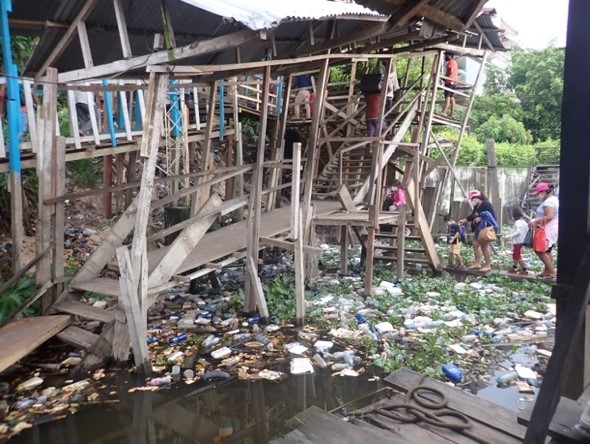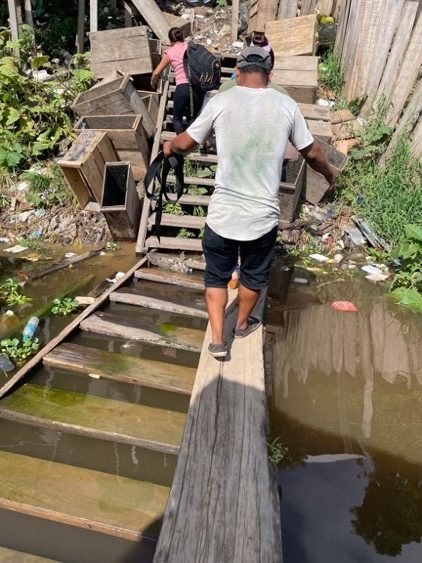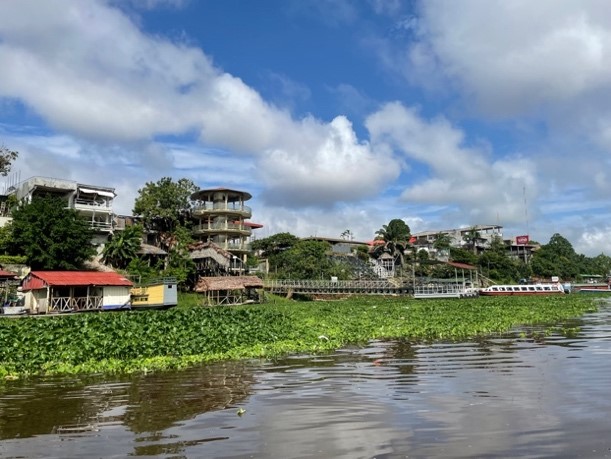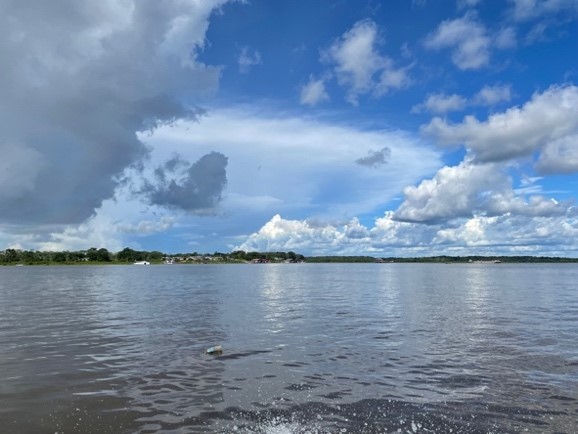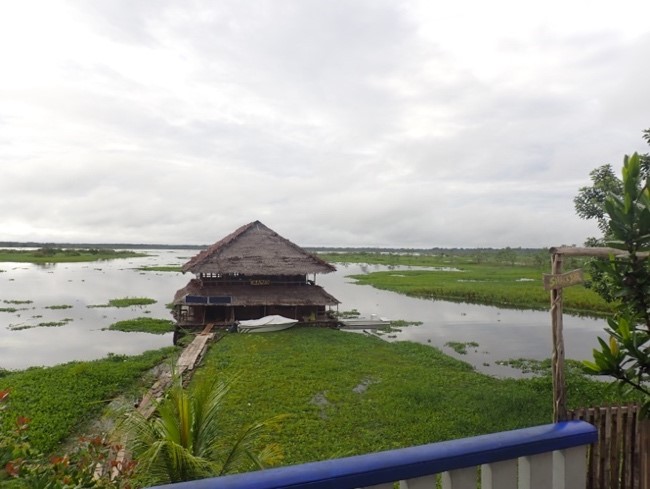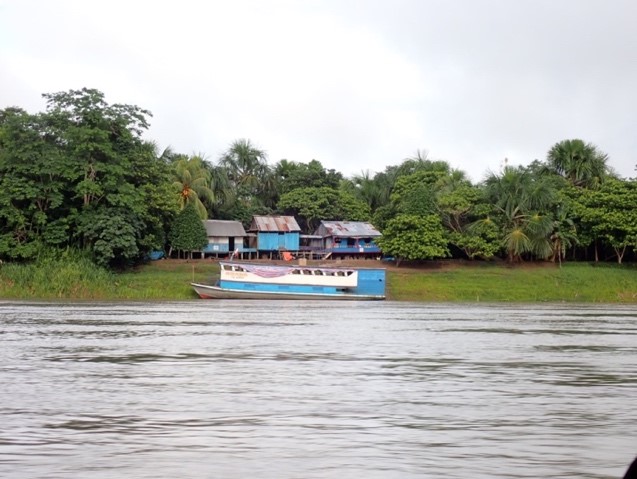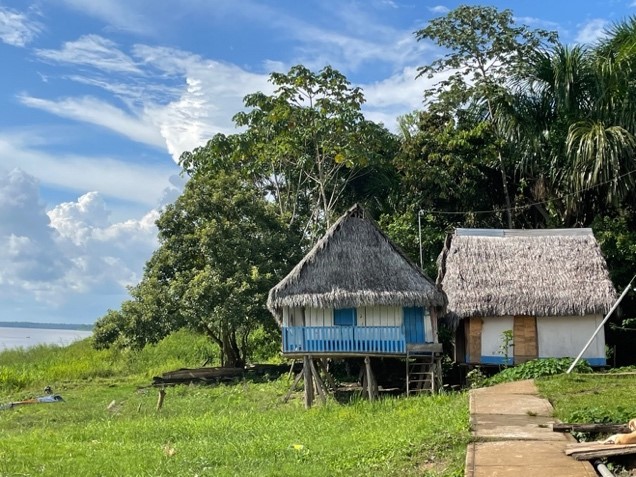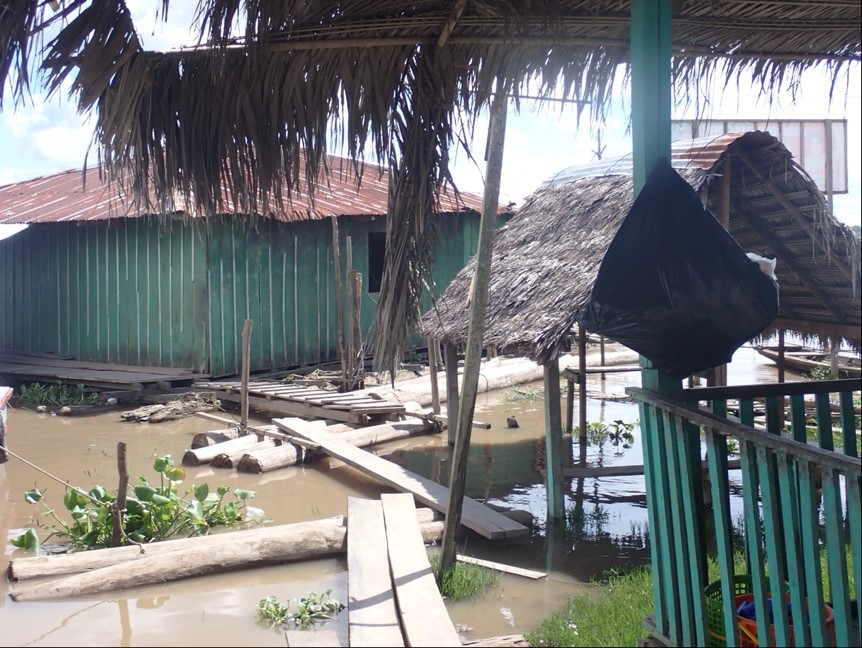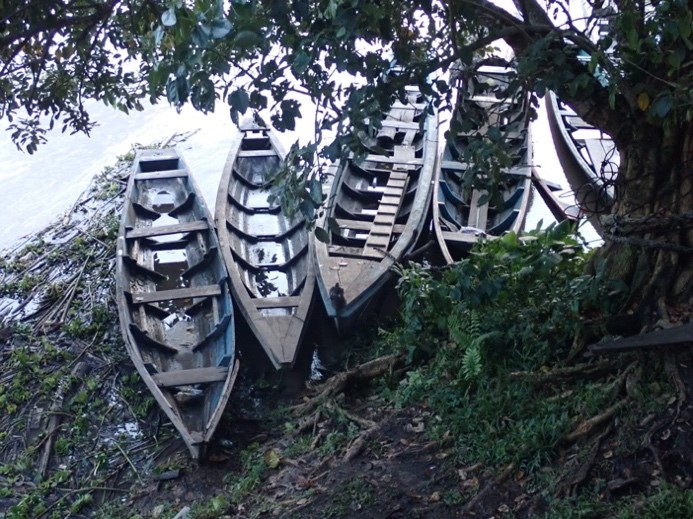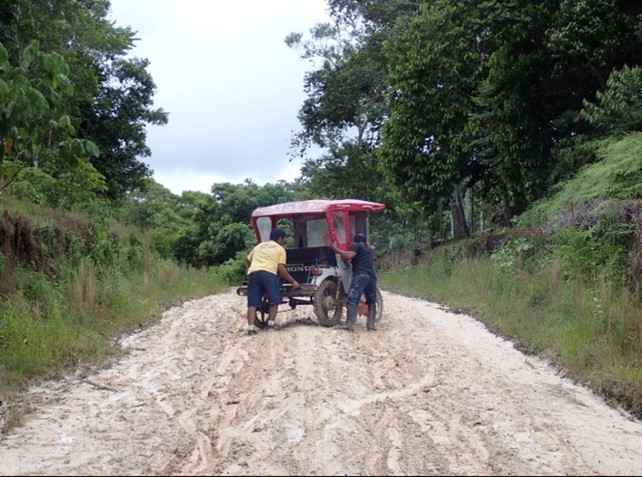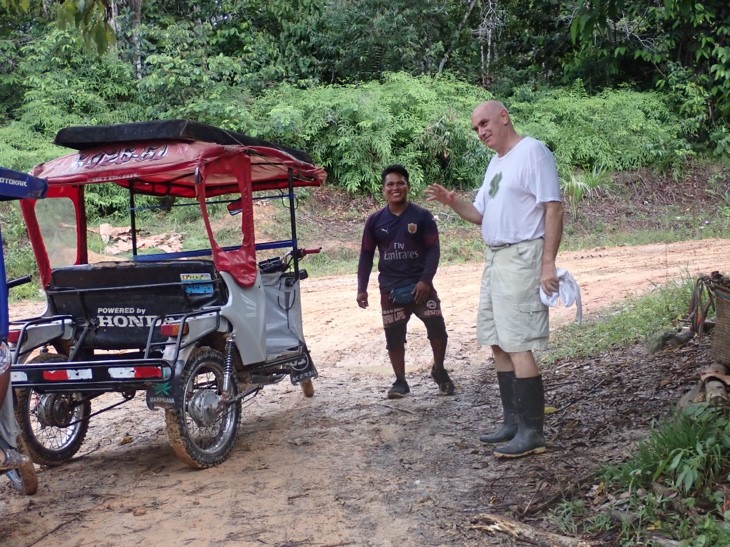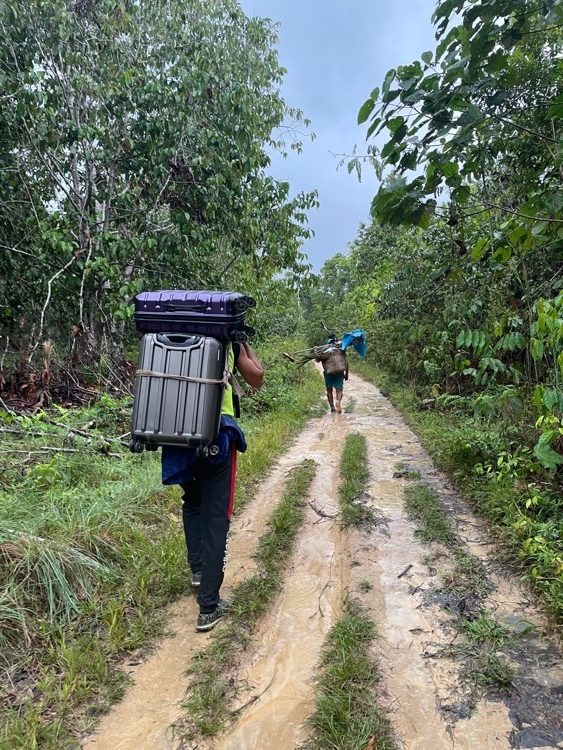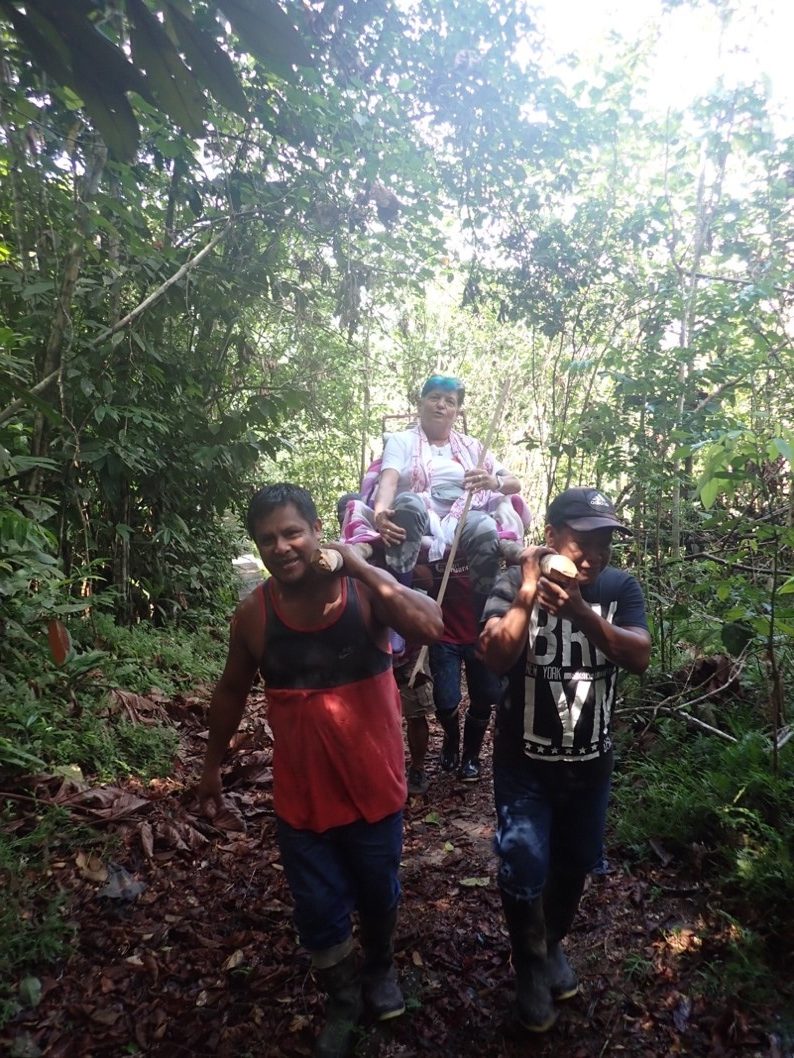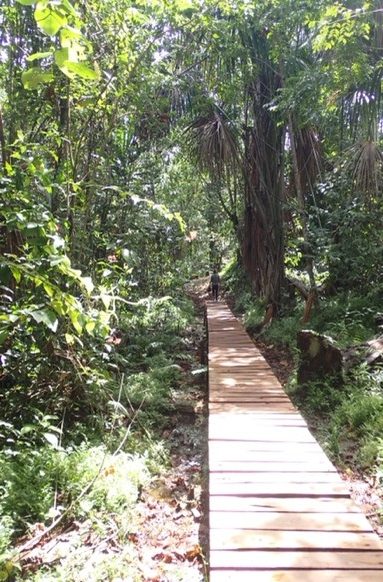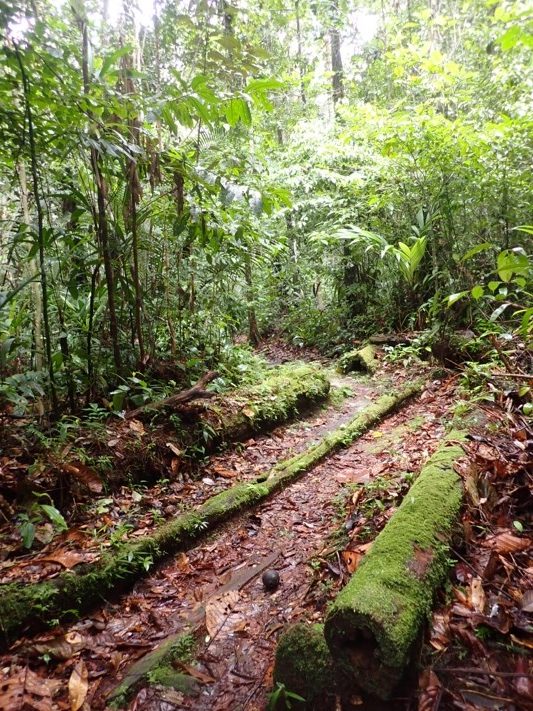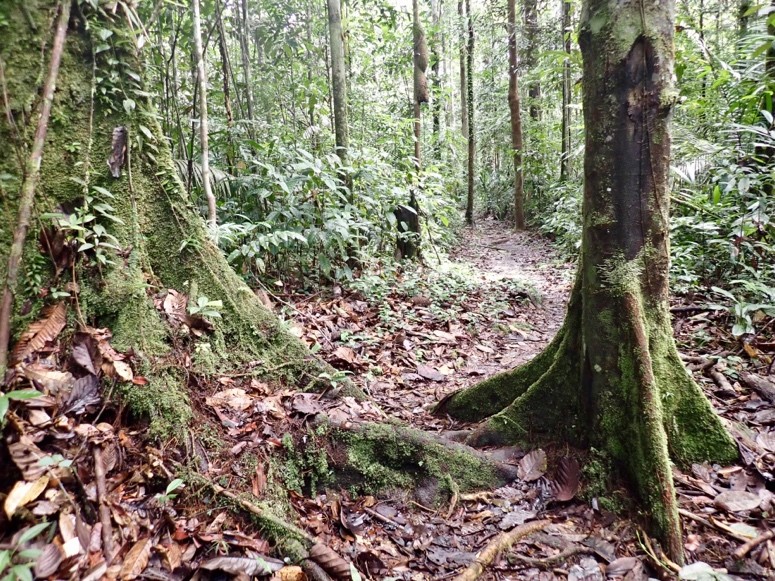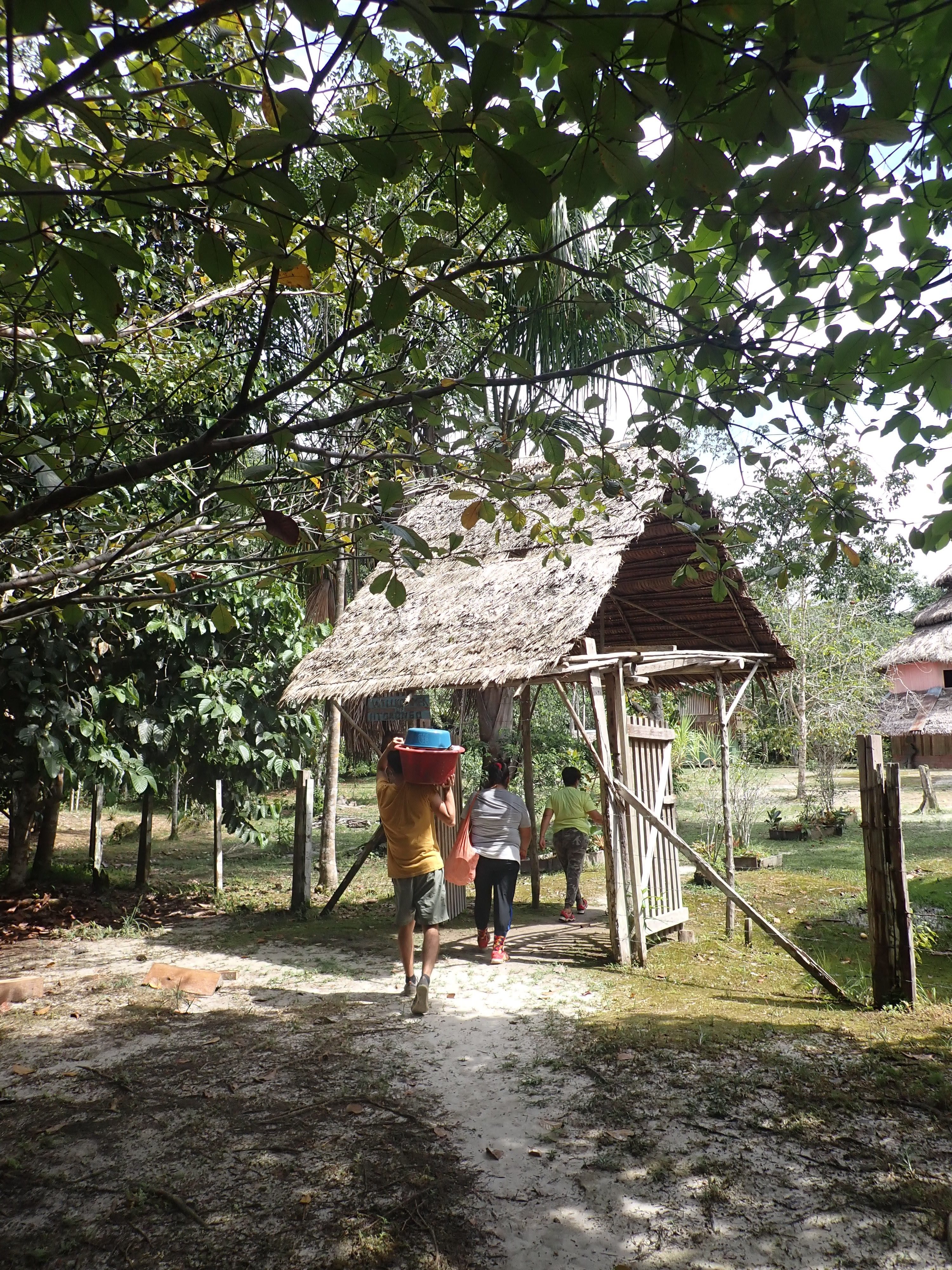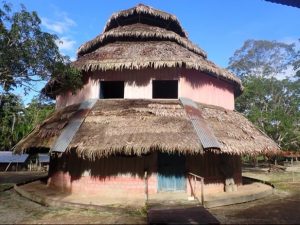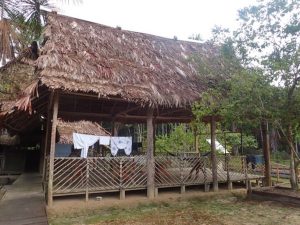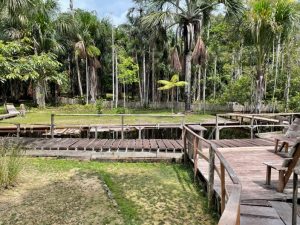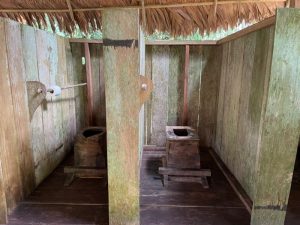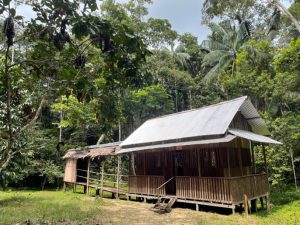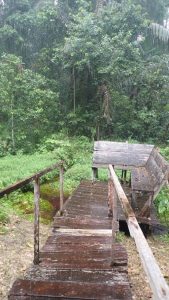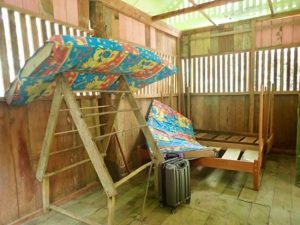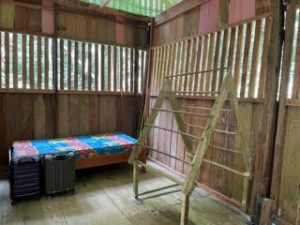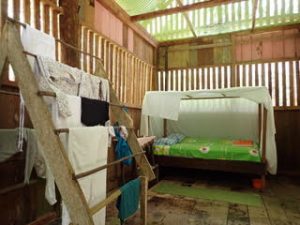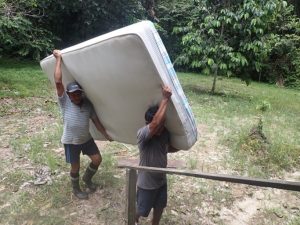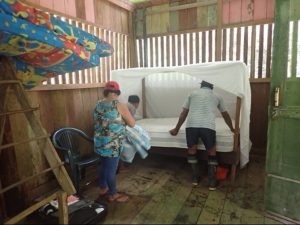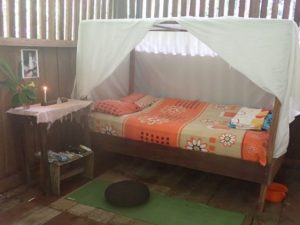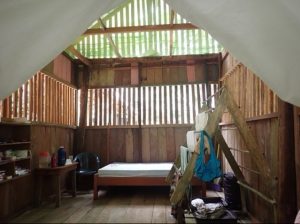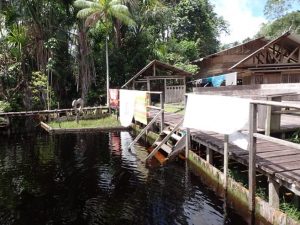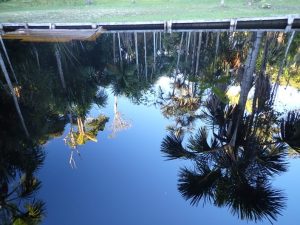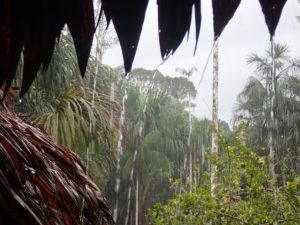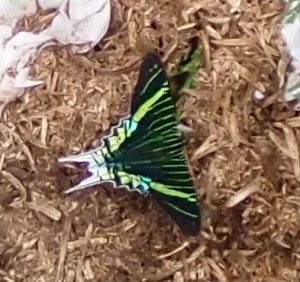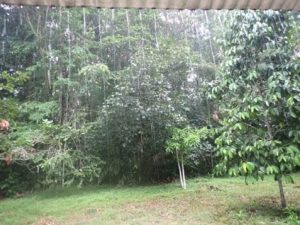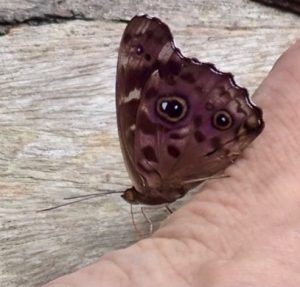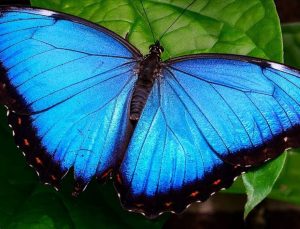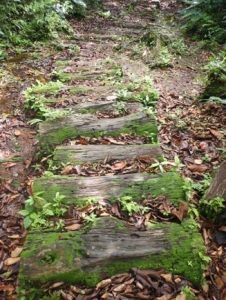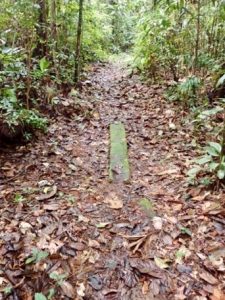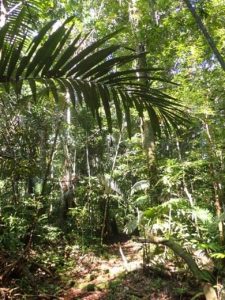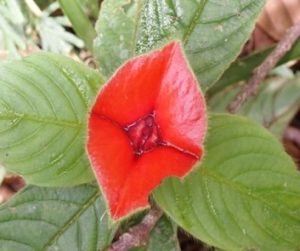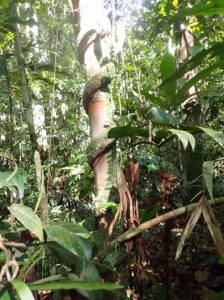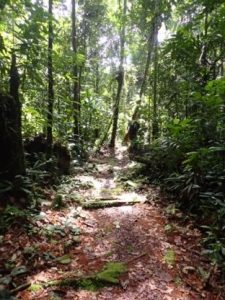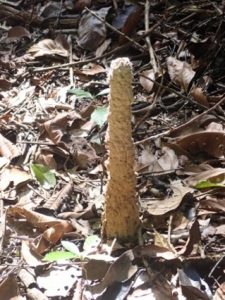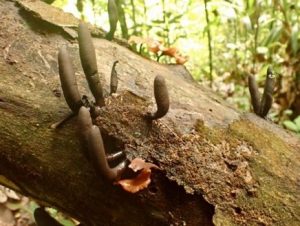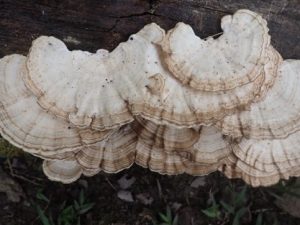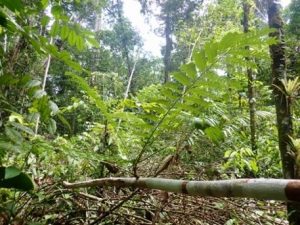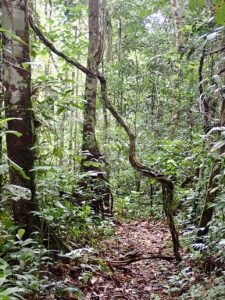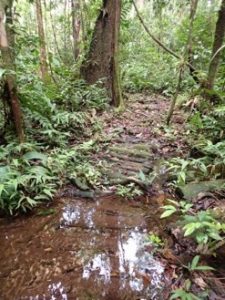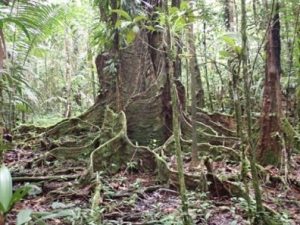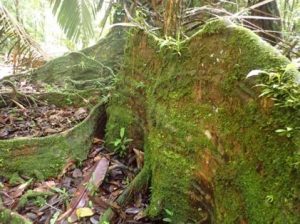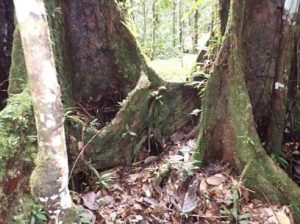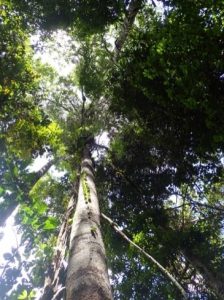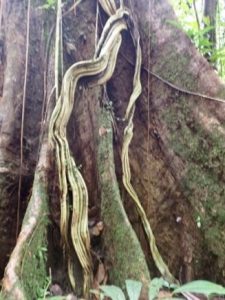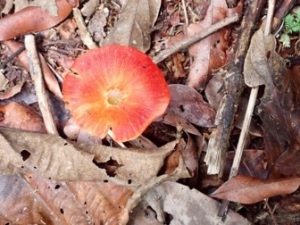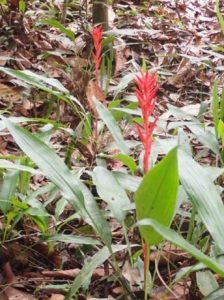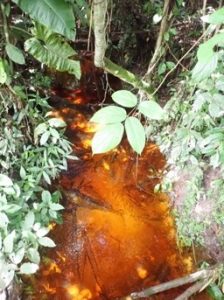Again we have the opportunity of having Garyo’s exquisite travelogue
with her special experiences and splendid pictures
staying in the Peruvian rain forest for five weeks.
Experiences in the Peruvian jungle
A little over a month ago, I came back form a five-week long retreat in the northeastern part of Peru near the Amazon River. Three weeks of my time in the rain forest, I stayed in a wooden hut outside of the camp of Otorongo, where I lived in silence with hardly any human contact. I did a dieta with only two vegetarian meals a day and no salt nor sugar. Sometimes, I had fish. My intention to do this silent retreat was to get in closer and deeper contact with nature. I would like to share my experiences with you.
The travel to Otorongo was already an adventure in itself. I went by plane from Lima to Iquitos, a border town between Ecuador, Colombia and Brazil. The travel continued by speed boat up the Amazon River (one hour) to a village called Tamshiyaku. From there I went by motorkar (30 minutes) on a dirt road to the jungle path leading to Otorongo. It takes about one hour by foot through pristine rain forest to reach Otorongo.
A dangerous and very fragile looking wooden structure made out of chaotic stairs and narrow wooden boards leads down to the Amazon River where the passenger boats are waiting for their customers. Incredible amounts of trash mixed with floating water plants cover the water near the shore.
Balancing on a narrow wooden board from the boat to the shore
Years ago, the city of Iquitos built a new harbor (see photo above). However, the lack of technical skills and also the use of cheap materials because of corruption made the structure collapse.
At Iquitos, the Amazon River is about 1 km wide. Many green islands made out of water plants float down the river. The masses of water have incredible strength and power. It might be the only river which has not been tamed by humans. I loved the colorful little boats and the simple, wooden houses at the shore
Floating water plants
A few houses are scattered here and there along the Amazon River
Picturesque houses at the shore of Tamshiyaku
Houses on the waterfront in Tamshiyaku
Tamshiyaku is a well-kept village with several schools, a hospital, a huge market and asphalt streets. Roads outside of Tamshiyaku are dirt roads. Heavy rain makes them often unusable.
The motorkar in front of us got stuck in the mud. Our driver helped to push it up the hill.
The crossroad between the drivable dirt street and the start of the walk
To the right you see Dr. Himmelbauer, the owner of camp Otorongo.
My luggage is carried by an employee.
If somebody cannot walk, it is possible to be carried on a rocking chair bound to two posts. It looks scary to me, especially when they walk over more than 25 slippery bridges. However, their step is very sturdy and rooted and they never slip.
One of many bridges
The magic of the jungle starts with the one hour walk to Otorongo
Thick moss grows on trees, ground and bridges not used much
Entrance to Otorongo
Experiences in the Peruvian jungle
Moving into my little hut
Otorongo, a Quechuan name meaning the place of the jaguar, is registered as a Franciscan monastery. Dr. Himmelbauer, an Austrian psychologist and trained curandero or vegetalista (plant shaman) has owned the place since 2002. He combines Christian values with Buddhist teachings and Shamanistic knowledge. These three spiritual pillars find expression in the main building of Otorongo – an octogonal wooden structure with 12 windows and a palm leaf thatched roof, which tapers in four levels upwards like a Buddhist Pagoda.
The temple where healing ceremonies take place
Wooden cabins for accommodation with palm leaf thatched roofs are randomly scattered in the fenced in camp area. The other buildings are the kitchen and dining room, toilets, a hut for storing coal and a storage cabin. However, I did not stay in the camp but moved into a wooden hut about 200 m outside the camp in order to start my 3-week long diet in silence.
Terrace in front of the dining area and kitchen
Walkway to a little pond inhabited by many turtles and fish
Toilets on the camp are organic and open. However, I had my own toilet attached to the cabin.
The diet hut is placed in the middle of a jungle clearing and stands, like all the other cabins, on stilts. The walkway to the left leads to the toilet, which is just an open pit to the jungle floor.
Walkway down to the creek, which always was very slippery and I had to hold on to the fragile railing.
Slippery walkway down to the creek
The cabin was not used for years and had to be prepared for me to move in.
Milton and Luis, the workers in Otorongo, brought a better mattress for the main bed. On my request, they moved the second bed to the other side of the room and also brought a second table where I could eat (originally, there was no table available, but they must have taken a table from their own cabin)
The mattress did not really fit into the frame and was too wide at one side and too short at the long side. However, they managed to fit it in. The bed was covered by a pure white mosquito net. In German, these beds are called Himmelbett – bed of heaven.
After everybody had left, I immediately started to make the cabin homy and nice and was very happy how it felt and looked.
Beside the bed, I placed the table I used for an altar. Judith brought a red and white patterned piece of cloth I used as a tablecloth. The little stool underneath the altar I used for things I needed during the night, like a flashlight, candles, matches and my watch. I brought the yoga mat and the meditation cushion from Austria. The orange pot to the right underneath the bed is used during the night. I was advised not to step out into the jungle during darkness.
My first night
Otorongo is located 4 degrees south of the Equator. It gets dark around 6 pm at 6 am it becomes light again. The main light sources in the camp are candles, as there is no electricity. Cellphones are of no use, there is no reception and anything that needs to be charged has to be brought to the village.
It was already pitch dark outside when I locked my door, laid down my green yoga mat and the zafu, lit the candle and incense on the altar and started to meditate. The songs of thousands of crickets penetrated the inside of the cabin like a wall of sound. In the distance, the deep croak of a single bull frog was calling for a mate, another nocturnal animal made a screeching sound over and over again. I tried to focus on my breath but was constantly pulled outward. It was very hard to concentrate. After a while, I heard a quiet tapping, the sound of hasty scurrying up on the ceiling. I stopped my meditation, switched on my flashlight and looked for the source of the noise. Two rat like animals were running around on the ceiling beams, having the best time of their lives. They were not at all bothered by my light and stared at me with their big, brown eyes.
View from my bed to the other side of the room
I decided to go to bed, closed my mosquito net and was looking forward to reading the book “Inside Vasubandhu’s Yogacara” by Ben Connelly. However, the tapping became wilder and wilder and I switched on my flashlight again to see what was going on. The light was falling on one opossum nibbling on my sweater. I chased it away and packed all my clothing into the suitcase again. During that time, the other opossum jumped on my bed. With a loud and determined voice I said “we will share the cabin, but you cannot come into my bed!” It looked at me with big eyes and disappeared under my bed.
Opossum on the ceiling beam
Around 10 pm, I was falling asleep. A bit later, something was pulling at my hairband and woke me up. It was the opossum again! I jumped out of the bed and saw the other opossum sitting on the small wooden cabinet eating my wooden earring. It had nearly finished it up to the silver hook. In addition, a bat got trapped under the metal roof. I heard a flapping sound tapping constantly against the metal panels. When I pointed the flashlight up to the roof, a red eye stared down at me.
The whole spectacle ended around midnight. I was convinced that Dr. Himmelbauer was not aware of the problems I was facing and that I will move into a cabin located inside the camp the next day. At 2:30 a.m. I was woken up by a dream.
I was holding on to a railing, under me a deep abyss. The situation seemed deadly. My sister, however, was standing on firm ground and I was shouting to her “you silly donkey, look at me, I need help!” She pulled me to safety and we had a big laugh when I was safe.
Pond in Otorongo
Reflections in the pond
That morning at 6 a.m, I met Dr. Himmelbauer for a short ceremony at the pond to start my 3-week diet. Afterwards, I told him about my encounter with the animals. He just smiled and said: “Now the war starts! You are challenged!”
He gave me two options – either to move into a cabin inside the camp or take on the challenge and become creative. “You are in the jungle, dear Mrs. Wild! The opossums are aggressive animals. They once ate my expensive leather watchband. There are other animals too that can visit you, like a boa! It is up to you!”
I decided to stay.
Experiences in the Peruvian jungle
Magical Reality
A dieta in the Upper Amazon jungle means no salt, no sugar, no sex, living in isolation and eating once a day plantain grilled in their own skin and pescaditos (green bananas and fish). The purpose of this diet is to lose the smell of the human body. It is said that spirits, plants and animals are very sensitive to smells and one has to acquire the smell of the forest in order to come closer to the other-than-human world.
My diet was not as strict. I had a simple, vegetarian meal twice a day. Also, I had no expectations and was more curious about the effects of isolation in the jungle on my inner life. However, the spiritual sphere of the jungle revealed itself by real-life events, interpretations and stories. I was immersed in another world.
One night after about a week of my dieta, I crawled into my bed, closed my mosquito net and started to read. Suddenly, the mattress began to tremble and I felt as if the opossums were nibbling inside of it. I jumped out of the bed and shined the light under it -nothing there, just wooden boards holding the mattress. No opossums anywhere! Could it really have been Chullachaqui wanting to trick me and trying to get attention? Dr. Himmelbauer had suggested this possibility. I pushed this thought away, it was too weird.
Other times, when it was already dark and the sound of rain swallowed up any other jungle noise, I heard human voices coming from the jungle. It was like a murmuring, a very gentle conversation between a man and a woman. I knew that no human being would be in the jungle at this time. Was it the sound of rain tricking me or did I really hear trees talking to each other? I explained it away as the sound of rain. The same happened when I heard steps in the darkness in front of my cabin? Two times I took the flashlight and searched outside for the cause of this sound. Nothing was there. Who is playing piano on the screen of my consciousness? My brain? The rain? An unknown spirit?
Magical butterfly sitting under my toilet
Every morning, I stepped outside the cabin to greet the elegant and slender Humari tree in front of my hut. Underneath it, there lived a gorgeous spider, crawling over the grass and hanging on the thin spider thread like the most gifted acrobat.
Humari tree on the right
During this time, a hummingbird often came by, flying right and left in front of my face and peeped as if it would like to say “good morning, good morning!” On the 21st day, the last day of my diet , I was sitting in meditation in my hut when the hummingbird suddenly flew to my left ear, stopped for a short moment and disappeared again through the open entrance door. I was stunned! When I stepped out afterwards, it came to greet me again for the last time. Was this really just coincidence?
Most of the time around noon I was sitting on the wooden stairs just doing nothing and taking in the atmosphere of the jungle. A butterfly discovered my presence and often landed on my leg or arm and scanned my skin with its tiny antenna.
I was told that the end of November was the time of butterflies emerging. Indeed, I saw more and more colorful butterflies. The most beautiful and magical, however, was an iridescent metallic blue butterfly circling the clearing nearly every day. This rare butterfly is called morpho menelaus and is one of the largest butterflies in the world (up to 12 cm wingspan). I was in awe about this graceful, very mysterious being! When I was walking in the jungle one time, it touched my right arm when it was flying by. Another time, it flew into my chest. “The animals want to get to know you,” Dr. Himmelbauer said when I told him about these encounters.
Morpho menelaus butterfly (image from the internet).
Dr. Himmelbauer advised me not to take photos of butterflies. They are magical beings. I did not make a photo of the Morpho menelaus, but could not resist taking photos of others.
I surprised myself that I was not afraid to be alone in the hut with all these unusual surroundings. The weather was very unstable with lots of thunderstorms and heavy rains. Sometimes, sheet lightening illuminated the clearing during the night with a constant nervous, flickering light. One time, an earthquake was shaking the entire cabin. Shortly before, a group of parrots felt it coming and made the most deafening noise. Despite all this, I felt embraced by the jungle. I felt, I was part of this jungle world.
Walking in the jungle
On the 5th day of my diet, I finally had the strength to do longer jungle walks.
Dr. Himmelbauer suggested that I first walk to the Chullachaqui-caspi tree and then to the spring, which would bring me back to the main path. With my barefoot shoes and walking stick, I started my hike with a queasy feeling in my stomach. The path is called “jaguar path” and one of the trees along it has marks from a jaguar sharpening his claws. I was advised to immediately return to the camp when I hear birds breaking out into a frantic noise – this would be a warning sign that a jaguar is somewhere close.
In order not to get lost, I made arrows from wooden sticks and laid them down at crossways. They blended into the leaves and were hard to see.
Thousands of different shades and hues of green were surrounding me when suddenly my gaze was caught by the sight of a wonderful being. It was a dragonfly so transparent that I only could see two floating, fluorescent yellow points at the end of its wings.
In the same moment, however, a deep roar was coming from the left. Immediately, I thought that I had disturbed the siesta of a jaguar and I was in severe danger. As fast as I could, I returned to the camp with the shock still in my bones.
A liana embracing the tree like a snake
Dr. Himmelbauer assured me that the roar of the jaguar is so penetrating and loud that it would stop every sound in the jungle. In addition, he told me that a jaguar had not been sighted for more than 6 months in this area and there are other, smaller cats in the jungle. Furthermore, he claimed that those on a dieta are never attacked. I should not be afraid. His words really calmed me down. At the same time, I was aware that he was contradicting himself. He once said that a jaguar is passing the path about once a month. It took all my courage to walk on this path again. Each day, however, it became easier and soon I was not afraid anymore. Also, each day I saw different fascinating things.
Wasps were building this tower for their offspring
A unique growth on a dead tree trunk
Mushrooms on a dead tree trunk
The path to the Chullachaqui-caspi tree is a gorgeous jungle path blanketed by dead brown leaves. Sometimes, fallen trees blocked the path and I had to climb over or under them. Here in the jungle, trees often fall to the ground, especially after a heavy rain. When this happens, the trees fall with a dull thud and the jungle floor is trembling nearby. Natives say that the trees are tired and want to rest. Sometimes, new shoots grow out of the trunk, as parts of their roots still are connected with the soil.
Fallen tree with a new shoot
During my first two walks, I could not find the Chullachaqui-caspi tree, a peculiar tree on stilts with unusual knots and lumps inside. “Chullachaqui is tricking you”, Dr. Himmelbauer said when I told him about it.
Chullachaqui is the Lord of the Forest and master of animals in the Amazon jungle. He lives in the Chullachaqui-caspi tree and rests under the Caimito tree. His appearance is that of a dwarf with two uneven feet (one animal and one human foot) and legs of different length. He is known as a trickster, often leading people astray. He can appear to people day or night and is able to choose any form he wants. Although I did not really believe in the stories of Chullachaqui, I still had an open mind for the plurality of worlds and the existence of all kinds of spirits. Therefore, I followed the advice not to make a photo of these two trees in order not to disturb their magic.
After I had found the Chullachaqui-caspi tree, I realized a vine growing just several meters before it. The vine became the marker for the tree.
I found the way to the spring and later on to the two huge medicine trees.
The spring
With their giant, wavelike buttress roots, the medicine tree looked like a swirling dervish dancing the sacred dance. This tree is about 1000 years old.
Giant root
Often, simple bridges lead over swamps and small creeks
Giant mother and daughter trees connected by a root bridging the two trunks. The buttress roots and their connection give them enormous stability.
The entire walk to the Chullachaqui-caspi tree and medicine trees took about 2 ½ hours. I knew where the Huyhuyshu birds will sing and that the rustling sound in the leaves is most probably from a lizard disappearing from the path.
Day and night, birds can be heard in the jungle. However, it is very hard to see them.
In order to connect better with trees and plants, I always took drawing utensils with me and looked for good subjects to draw.
Whenever I stopped walking, mosquitos immediately were all over me, especially near water.
Due to minerals, the color of the water is reddish. Deeper water is black


